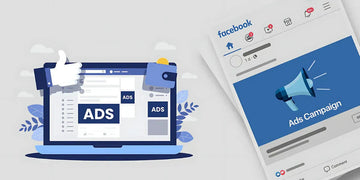Facebook is one of the best social media tools for entrepreneurs trying to reach the world. The platform offers an incredible opportunity for businesses, creators, and marketers to sell their products or services that have well over 3 billion active monthly users.
However, creating Facebook ads is not as simple as clicking a button. You need to understand every aspect of Facebook advertising, develop a well-organized campaign, and consistently track the campaign's outcomes to ensure success.
In this guide, we’ll take you through the entire process of creating and running effective Facebook ads.
Why Advertise on Facebook?
With over 3 billion users worldwide, Facebook is the second most visited website and, combined with advanced targeting options, is among the most powerful advertising platforms.
Facebook gives you all of the tools you need to connect with your audience, whether you own a small business or a large corporation.
Below are a few reasons in brief why Facebook ads are a beautiful alternative for all types of businesses:
Access to a Large and Diverse Audience
Facebook has over 3 billion active users worldwide, so you can reach a large and diverse audience.

Advanced Targeting Capabilities
Facebook aggregates a plethora of information on its users, which advertisers can then use to tailor their ads according to demographics, location, people’s interests, behaviours, life events etch.
Performance Monitoring in Real-Time
With real-time data, you can immediately see how well your ad is performing and make real-time adjustments to your campaign if needed.
Cost-Effective Advertising
Facebook ads are also cost-effective when compared to traditional advertising platforms, such as TV, print or radio.
What Are Facebook Ads?
Facebook ads (or Facebook advertisements) are paid ads that show up on users’ Facebook feeds, in the right-hand column of Facebook, and other places on Facebook and its associated platforms like Instagram.
These advertisements assist companies in showcasing their products or services to a specified audience. You can customise the ads to achieve a range of objectives, such as increasing brand awareness, boosting sales, or encouraging app installs.
Facebook Ads Manager is required to create and manage Facebook ads. As a result, you have full control over your campaigns. You can determine the target audience and your budget and track the performance of your ads.
Facebook Ad Types
There are many ad formats on Facebook that a person can use for many campaign objectives. One of the key steps in designing successful ads is to understand the correct format for your goal. The most common types of Facebook ads are:
Sponsored Posts
Sponsored posts are the most common type of Facebook ad. They show up right in users’ News Feeds, appearing organic with posts from friends and pages they follow. This makes them more engaging than regular ads, which often experience lower engagement rates.

Whichever social media platform you choose, note that sponsored posts will help improve brand reach and give you an audience to interact with.
Right-Hand Column Ads
These are smaller, less intrusive ads that run, like the ads on the right side of Facebook’s desktop site. They may not be as flashy as sponsored posts, but work wonders for retargeting campaigns, targeting users who have previously interacted with your brand. They can also work well for driving traffic to your website or product pages.
Carousel Ads
Carousel ads let you display several images or videos within a single ad. Users can swipe through the images or videos, which means it is excellent for highlighting multiple products, features, or services. This format is ideal for e-commerce businesses to showcase multiple products or categories.
Video Ads
Video advertisements can help you tell a story, present product demos, or promote testimonials. They are much more interactive and can grab more attention than static pictures. Video ads are excellent for building brand awareness and explaining complicated products or services.
Collection Ads
Collection ads are designed to provide a full-screen experience for sharing a group of products. This is a good format for e-commerce businesses that want to showcase multiple products at the same time. This is an interactive and they are a fantastic approach for increasing conversions.
Effective Steps for Running Facebook Ads
Here is the step-by-step guideline to run successful ad campaigns on Facebook:

Set up a Facebook Ads Manager account
Before you can run Facebook ads, you have to set up a Facebook Business Page. You cannot run ads on personal Facebook profiles.
After creating your Business Page, you will have access to Facebook Ads Manager, the central hub for creating and managing ads.
To begin, simply log into your Facebook account and navigate to Ads Manager. So follow the steps given to get your account set up and input your payment details.
Define Your Campaign Objective
When you open Facebook Ads Manager, it will prompt you to select a campaign objective. This ensures that the ad strategy and the best ad formats used are suitably aligned to overcome this objective in your campaign. Facebook offers multiple objectives:
Brand awareness: Get the word out and reach more consumers.
Traffic: Get visitors to your website, app or landing page.
Engagement: The number of interactions with your posts, for example, likes, shares, and comments.
Lead generation: Use to gather prospects' information.
Conversions: Drive actions, such as product purchases or form submissions.
To generate leads, increase website traffic, or boost sales, choose the right objective based on your business goals.
Set Your Target Audience
Facebook's most powerful asset is the ability to find niche audiences. You can target your ad based on demographics, location, interest, and customer behavior pattern. Moreover, Facebook offers three types of audiences to select from:

Saved audiences: Audiences that are defined by interest or demographic.
Custom Audiences: Target people who are already engaged with your business (e.g., website visitors, email list subscribers).
Lookalike Audiences: Discover more people who have similar traits to your best customers.
Well, the more precise you can get with your targeting, the better your ads will be.
Create Your Budget And Schedule
Depending on your needs, you can set a daily or lifetime budget. A daily budget defines the highest amount you are willing to spend each day, whereas a lifetime budget determines an overall amount for your entire campaign.
There is also an option for you to run your ad set continuously or for a selected amount of time.
Select Placement of Your Ads
You can also select where to show your ad on Facebook. You can also let Facebook place your ads automatically. Available options include:
Feeds: ads that appear in the news feed on Facebook and Instagram.
Stories: Ads displayed full-screen in Facebook and Instagram Stories.
Messenger: Ads appearing in Facebook Messenger.
In-stream: Ads that appear during videos on Facebook.

Create Your Ad
Once you’ve chosen your audience and placements, it’s time to build the ad itself. Facebook formats include single image or video ads, carousel ads, and collection ads etc. Use strong visuals and highlight detailed graphics with succinct ad copy. Add a compelling CTA (Call to Action) at the end, like Shop Now, Learn More, Sign Up, etc.
Tips for Running Effective Facebook Ads
After your ads are running, tracking performance becomes important. You can keep track of important metrics — including reach, impressions, CTR, CPC, and conversions — using Facebook’s analytics tools.
Periodically review these metrics and, if necessary, tweak your campaign. This procedure allows you to test and optimise performance for different images, copy, and targeting.
A/B Testing: They test multiple iterations of your ads to see what resonates. Test changes to your copy, visuals, or targeting to help optimise your results.
Stunning Ad copy: Your ad copy should be concise, clear, and focused on the benefits of your product or service.
Use high-quality visuals: Your ads, whether they are images or videos, should be visually appealing and relevant to your message.
Strong Call-to-Action (CTA): Make sure you have a strong CTA that tells users exactly what to do.
Retargeting: Implement retargeting to reconnect with users who have engaged with your brand or website.
Monitoring and optimising: Regularly check how your ads are performing and adjust accordingly to achieve better results.
Conclusion
Facebook is one of the most powerful tools for marketers because of its massive audience and user-friendly targeting features.
The power of running your Facebook ads is an effective and low-cost way to promote your brand, drive traffic, and increase sales for your business.
With Facebook Ads Manager and the steps above, you can create ads that are well-targeted to your ideal audience and deliver results that you can measure.
Now that you know how to set up your Facebook ad campaigns, you are ready to run them successfully.
Define your objective, choose the right audience, create compelling ads, and monitor your performance. So start Facebook Ad campaign successfully now and boom your business.












